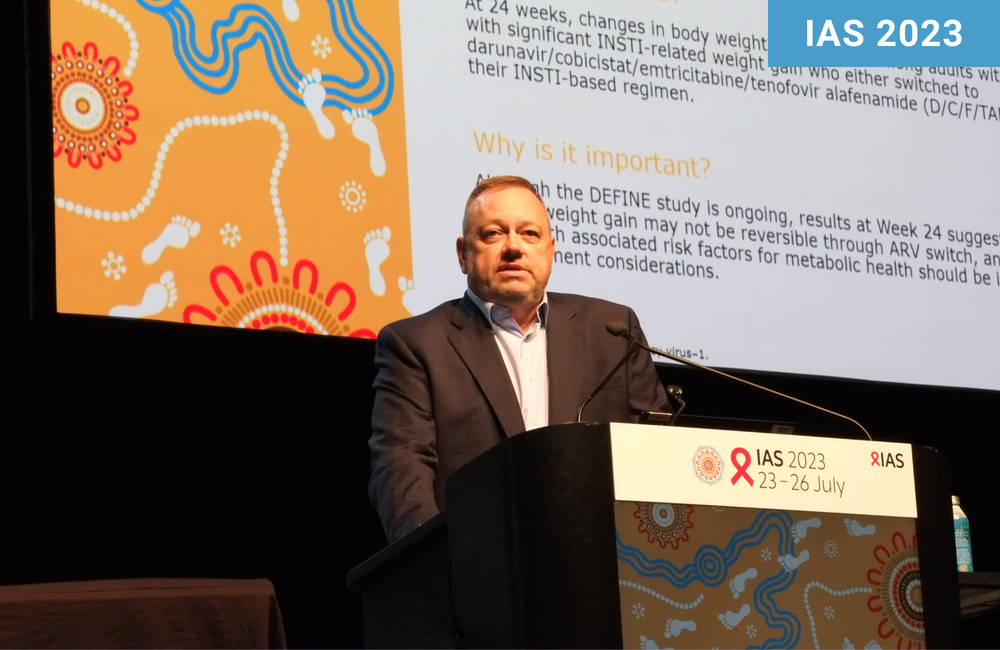
Switching from an integrase inhibitor to another regimen did not reverse weight gain in two studies that tested alternative regimens, researchers reported at the 12th International AIDS Society Conference on HIV Science (IAS 2023) this week in Brisbane, Australia. Indeed, people who switched away from integrase inhibitors continued to gain weight at a similar rate to those who stayed on an integrase inhibitor-based regimen.
In a discussion of the metabolic consequences of weight gain, Professor Francois Venter of the University of Witwatersrand said that other pharmaceutical options need to be explored for addressing weight gain in people with HIV, such as the use of GLP-1 receptor agonists. He said activism will be required to bring about studies of new agents such as semaglutide (Wegovy) in people with HIV who have experienced substantial weight gain on antiretroviral treatment.
Weight gain is common after starting antiretroviral treatment. Some studies have shown that weight gain is greater in people taking integrase inhibitors, but it is unclear if this is because they are being compared to efavirenz and tenofovir disoproxil, two drugs that seem to suppress weight gain after starting treatment. Higher body mass is associated with a higher risk of cardiovascular disease and metabolic disorders, so measures to reverse substantial gains in body weight are desirable, especially in older people who have a higher risk of these conditions.
Working on the assumption that some antiretroviral drugs have a greater impact on weight than others, several research groups have designed studies that look at the impact of replacing an integrase inhibitor with another type of drug. Two studies reported on this approach at IAS 2023 this week but didn’t offer much encouragement to pursue this strategy.
DEFINE study: switching to a boosted protease inhibitor
The DEFINE study tested the impact on weight of switching to a boosted protease inhibitor in 103 people with HIV in the United States who had experienced weight gain of at least 10% on an integrase inhibitor-based regimen.
People were eligible to join the study if they had maintained suppressed virus on a regimen containing an integrase inhibitor, tenofovir alafenamide and emtricitabine for at least six months and had gained at least 10% in body weight over three years while taking this regimen. Anyone taking other medications that could be associated with substantial changes in weight was excluded from the study.
Participants were randomised to switch to a fixed-dose once-daily combination of darunavir / cobicistat / tenofovir alafenamide / emtricitabine (Symtuza) (53 participants) or remain on their existing integrase inhibitor-based treatment (50 participants).
Thirty per cent of study participants were female and 61% were Black, the median age was 45 and the median CD4 count was 680. Most participants were taking bictegravir / tenofovir alafenamide / emtricitabine (Biktarvy) (81%). The median weight was 100kg, the median body mass index was 32.7 and participants had gained a median of 14% of body weight on their current regimen.
The primary outcome of the study was the percentage change in body weight from baseline to week 24. There was no significant difference between the study arms at week 24. Weight increased by 0.63% in the switch arm and decreased by 0.24% in the integrase inhibitor arm.
However, there was considerable variation between participants. Eleven people in the switch group and six people in the integrase inhibitor group gained at least 3% in body weight, while seven people in the switch group and nine people in the integrase inhibitor group lost at least 3% of body weight.
There was no significant difference between sub-groups in weight change. Body composition measured by DEXA scan showed no change in body fat content over 24 weeks.
Ninety per cent of participants who switched to Symtuza maintained viral suppression at week 24 (the remainder had missing data at this time-point). Five people who remained on integrase inhibitor-based treatment experienced viral load increases above 50 during the study, but four of the five resuppressed viral load.
The boosted protease inhibitor regimen was well tolerated; 11% in the boosted protease inhibitor arm and 6% in the integrase inhibitor arm experienced at least one drug-related adverse event, most commonly diarrhoea and nausea. Total cholesterol increased from 179mg/dl to 211mg/dl in the switch arm but remained unchanged in the integrase inhibitor arm.
Switching to doravirine/islatravir
Professor Grace McComsey of Case Western Reserve University, Cleveland, reported on weight changes in two randomised studies of switches from an existing antiretroviral treatment to a combination of the non-nucleoside reverse transcriptase inhibitor doravirine and the nucleoside reverse transcriptase translocation inhibitor islatravir. Most study sites were in high-income countries, although PO17 did include two sites in South Africa.
In study PO17, participants switched from an existing regimen of any type to doravirine / islatravir, while in study PO18, participants switched from bictegravir / tenofovir alafenamide / emtricitabine (Biktarvy) to doravirine / islatravir. Both studies used an islatravir dose of 0.75mg. Investigation of this dose has since been discontinued due to concerns about white blood cell count reductions at higher doses of islatravir and future development will test a daily dose of 0.25mg.
In both studies, weight was measured at baseline and week 48; DEXA scans were also carried out at these timepoints to assess body composition.
The primary study outcome was the mean change in weight, peripheral fat and trunk fat at week 48.
In PO17, 14% of participants who continued to take their baseline regimen received a boosted protease inhibitor, 52% an integrase inhibitor and 34% a non-nucleoside reverse transcriptase inhibitor. Dolutegravir, efavirenz and boosted darunavir were the most commonly used anchor drugs in these regimens and 32% of participants were taking tenofovir disoproxil.
Study PO17 had a higher proportion of female participants (37%) than PO18 (33% in the doravirine arm and 24% in the bictegravir arm). Participants in PO17 had been on antiretroviral treatment for approximately two-and-a-half years compared to 14 months in PO18. Average body weight was similar in the two studies as was peripheral and trunk fat.
In PO17, weight gain was higher in the doravirine / islatravir arm when the comparator regimen contained efavirenz and/or tenofovir/disoproxil. Similarly, peripheral and trunk fat gain was greater in the doravirine arm when the comparator regimen contained efavirenz and/or tenofovir disoproxil. But if these drugs did not form part of the comparator regimen, there was no difference in weight gain between those who switched and those who stayed on their existing regimen.
The weight difference was modest. People who switched to doravirine / islatravir gained approximately 750g over 48 weeks while people who remained on a regimen containing efavirenz and/or tenofovir disoproxil lost 150g. Peripheral and trunk fat changes were also small.
In PO18, there was no difference in weight gain or fat gain between the two regimens.
Receiving treatment in the Africa region was associated with greater weight gain in the doravirine / islatravir arm in PO17, as was younger age and male sex (but in the case of the last two sub-groups, only where efavirenz and/or tenofovir disoproxil featured in the comparator regimen).
A need for other pharmaceutical interventions to treat weight gain on antiretroviral treatment
The recent approval of a drug previously used to treat diabetes as a weight loss treatment for people with obesity has excited interest in their use to treat weight gain in people on antiretroviral therapy.
Semaglutide, approved as Wegovy for weight loss treatment in the United States and European Union, is a GLP-1 agonist. It is assumed to work by curbing appetite and food intake. A trial in people without diabetes showed that people who took the drug lost 15% of body weight over 68 weeks compared to 2% in a placebo group who followed diet and exercise recommendations. However, people who stopped semaglutide in the same study regained most of the weight they lost within a year. To maintain weight loss on a GLP-1 agonist, it seems necessary to take it indefinitely. Weekly injections of semaglutide for weight loss cost $16,000 a year in the United States.
Semaglutide is also marketed as Ozempic for diabetes treatment. Four other GLP-1 agonists are approved for diabetes management.
Professor Francois Venter of the University of Witwatersrand, South Africa, speaking in the same session as the DEFINE study, said that managing the underlying weight gain on antiretroviral treatment is critical for combatting the development of metabolic disorders in people with HIV.
He said that studies of new pharmaceutical interventions to treat weight gain in people with HIV are needed.
“In the last few weeks alone, there’s been an explosion of new agents, but they are eye-wateringly expensive in rich countries and completely unavailable in low- and middle-income countries. We’ve started preliminary negotiations with the companies, to start looking at studies. Lifestyle changes, exercise and diet are incredibly important for your health but to shift weight downwards, in someone with established weight gain, is next to impossible, you really do need pharmaceutical or surgical help. We approached one of the companies and were told, quote, ‘HIV is not their priority’, so they are not going to support the study.”
“The levels of cost of these agents and the levels of overweight that we’re seeing in these communities are going to require some focussed activism in terms of access to these drugs, because there’s no way we’re going to be able to deal with this," Professor Venter said.
"There are clear drops in lipids, glucose, blood pressure once you drop weight. There haven’t been any clinical benefits [such as reductions in blood pressure or cardiovascular events] demonstrated in weight loss studies yet; it’s been demonstrated in diabetic populations, but not in non-diabetic populations. We need to start testing these agents in the HIV-positive population so that we can get access to these drugs for our patients as quickly as possible.”
Short WR et al. A prospective, randomized trial to assess a protease inhibitor–based regimen switch strategy to manage integrase inhibitor–related weight gain. 12th International AIDS Society Conference on HIV Science (IAS 2023), Brisbane, Australia, abstract OALBB0502, 2023.
View the abstract on the conference website.
McComsey GA et al. Weight and body composition after switch to doravirine/islatravir (DOR/ISL) 100/0.75 mg once daily: week 48 results from two randomized active-controlled phase 3 trials, MK8591A-017 (P017) and MK8591A-018 (P018). 12th International AIDS Society Conference on HIV Science (IAS 2023), Brisbane, Australia, abstract OAB0203, 2023.

